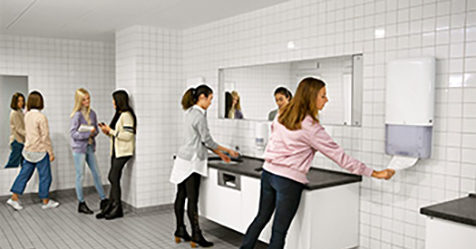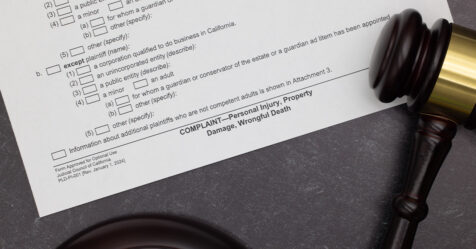When building owners and managers design public restrooms, they discuss, review, and consider countless features and products but consistently base their final decisions on two priorities: the number of individuals the restroom must accommodate at one time and the overall cost. Unfortunately, this narrow approach to restroom design leaves little to no room for considering the varying needs of the restroom users themselves.
Accommodate the boomers
The United States boasts a population of more than 341 million, according to the World Population Review. It’s fair to suggest that the majority have used or will use a public restroom some point during their lives. For many of those people, public restrooms are sufficient. That is, they provide access to the essentials, such as a toilet, toilet paper, a sink, soap, and paper towels and/or a hand dryer. But for many others, public restrooms present a myriad of challenges.
According to the 2020 U.S. Census, at 73 million strong, baby boomers—those individuals born between 1946 and 1964—make up 24.3% of the U.S. population, the second largest group after
millennials. The census also projects that, due to increased life expectancy rates and lower birth rates, older adults will outnumber children less than 18 years old for the first time in U.S. history
by 2034.
Not only do baby boomers make up the second largest group of Americans, according to Bank of America, in 2023, they spent a higher share of their income on travel and entertainment than any of the younger generations. Bank of America’s data also points to boomer spending remaining robust throughout this year, in part due to boomers delaying retirement, cost of living increases to
social security, and the fact that, in aggregate, they have roughly five times the amount of assets as millennials.
Collectively, the data suggests that a significant number of older Americans are now and will continue to go to work, dine out, attend live events, and travel the country. In all probability, they will
be using public restrooms while doing so.
Why age matters
No typical senior exists, and no typical aging timeline has developed. But during the aging process, molecular and cellular damage can occur over time, and often leads to a gradual decrease
in physical and mental capability. The World Health Organization lists aging-associated health conditions include hearing loss, cataracts, back and neck pain, osteoarthritis and diabetes. Scripps
identifies Type 2 diabetes, Alzheimer’s disease, and arthritis and joint replacement among the top health conditions affecting older Americans.
Each of these health conditions includes symptoms that can impact a person’s quality of life. Type 2 diabetes, for example, can cause nerve damage and foot problems that make it difficult to walk or stand. Cataracts can cause clouded or blurred vision that impacts depth perception. Arthritis can impact dexterity, mobility, and stability. And the general decrease in physical ability caused by aging leaves many seniors contending with fragile skin, a loss of grip strength, and a lack of coordination, along with instability and balance problems.
An awareness of these potential health conditions and their related limitations and impairments is crucial in designing restrooms that can better accommodate aging Americans who pursue active lifestyles.
Design with intention
Many public restrooms are designed to accommodate the “average” adult. According to the U.S. Centers for Disease Control and Prevention, the average adult male is 5 feet 9 inches tall, weighs just less than 200 pounds, and is 40.5 inches wide. The average adult female is 5 feet 3.5 inches tall, weighs more than 170 pounds, and is 38.7 inches wide.
All public restrooms are designed to comply with national health, safety, and disability regulations, which include everything from incorporating a baby-changing table and accommodating a
wheelchair to placing dispensers at accessible heights. While these factors are a great first step in ensuring a restroom meets a wide range of user needs, additional considerations emerge
when designing a restroom that also improves the experience for older Americans.
First and foremost, approach restroom design with the “Seven Principles of Universal Design” in mind. Developed at North Carolina State University in 1997, these principles provide a
framework for designing inclusive and accessible environments and products and for reducing or eliminating barriers to their use. The first principle, for example, is to design for equitable
use, which means making what you design usable by people with diverse abilities. Another principle focuses on designs that enable simple and intuitive use, and a third suggests designs that
require minimal physical effort.
These principles can be applied to the overall design of a public restroom and the features and fixtures it will include, such as by:
- Eliminating large, heavy doors at restroom entrances to make it easier for those with canes, walkers, and wheelchairs to gain access
- Installing touchless soap, sanitizer, and paper towel dispensers as well as touchless faucets and flush valves to eliminate the need for users to push buttons, press levers, and turn handles
- Purchasing products that are gentle on the skin, including soaps that both improve hygiene and are soothing and moisturizing and paper products that are absorbent and soft
- Increasing lighting to make it easier for older restroom users to see the layout of the space and potential obstacles such as garbage bins, and to read signs and labels easily
- Mounting larger disposal bins in stalls to accommodate incontinence products
- Incorporating stall doors that swing out to enable easier movement within the stall and to accommodate a walker or cane.
An especially senior-friendly restroom addition is the inclusion of at least one completely private stall that includes an adult changing station and is large enough to accommodate a restroom user
and a caregiver. Such a space will not only provide privacy, but it will help older restroom users maintain their dignity in what they may perceive as a vulnerable situation.
Take baby steps
For facilities working with the potential constraints of existing restrooms, taking baby steps to meet the needs of older individuals is a great way to start down the path of providing a more inclusive, universal restroom experience. Any step forward—be it changing out products to those that are gentler on the skin or using higher watt lightbulbs—is a step in the right direction.




